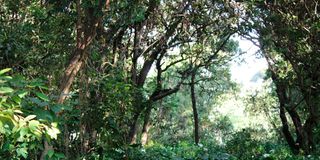Collective action on climate, biodiversity, pollution vital

A scenic site at the source of River Mutara in Thigio Village, Ndaragua Constituency, Nyandarua County
Global attention once more turns to tackling the climate crisis as world leaders, ministers, civil society groups, scientists and the private sector convene on Nairobi next week for the sixth UN Environment Assembly, hosted by the highest environmental decision-making body, UNEA.
Ambitions are high to restore harmony between humanity and nature, improve lives for vulnerable people and tackle the triple planetary crisis of climate change, nature and biodiversity loss, and pollution and waste. This requires multilateral cooperation and collective action on a global scale.
As a global climate action NGO, WRAP unites businesses to reduce waste—especially plastics and food—lower carbon and adopt sustainable water management. As a result of the latter, several UK companies have committed to source at least 50 per cent of all fresh food and drink from sustainably managed water catchments, under the Courtauld 2030 Water Roadmap.
We have mapped key fresh-produce sourcing areas in water-stressed regions and biodiversity hotspots in the United Kingdom, southern Spain, Peru, the Western Cape of South Africa) and, in Kenya, the basins of Lake Naivasha, Upper Ewaso Nyiro (Nanyuki-Timau areas) and Athi (Oloitokitok).
Water stewardship
Naivasha, home to hippos and African Fish Eagles, is essential to local communities, businesses and tourism and a designated wetland of international significance by the Ramsar Convention. It provides flowers and vegetables to Europe and the UK.
WRAP, working with WWF-UK, retailers and vegetable and flower companies, launched a collective action project building better water stewardship. WRAP is partnering with World Wide Fund for Nature-Kenya (WWF-Kenya), through the Kenya Collective Action Water Stewardship Project, to enhance sustainable sourcing and water management here with plans to extend the initiative elsewhere in the country.
Having suffered major water scarcity spells, there’s an urgency to ensure commercial flower farms use water sustainably, adopting appropriate waste-water management systems. WWF-Kenya and Water Resource Authority (WRA) provide technical assistance to flower farms in Naivasha to improve waste-water treatment with artificial wetlands where gravel and plants filter out pollutants, resulting in clean reusable water. Here, a powerful circular economy exists, reducing water use by 10 per cent.
Conservation of water sources is a collective action across government agencies, non-state actors, the private sector and local communities. Smallholder farmers take part under the Water Resource Users Association. In collaboration with WRA, WWF-Kenya has trained hundreds of locals as citizen scientists who conduct health assessments of rivers, collecting data on water quality and quantity.
Citizen science plays a crucial role, and community scientists in Nyandarua County-Lake Naivasha headwaters explained how they collect and identify invertebrates as part of the health assessment of rivers. This information, alongside pH, oxygen, and turbidity helps calculate river health scores via an app so WRA can direct attention to pressure points.
Collective action projects are dealing with problems at a water catchment level but action across these huge catchments needs the help of multilateral institutions. It requires the full attention of multilateral agencies with funding at a level to mitigate the triple environmental crisis for real change to the climate crisis to be possible.
These topics must be discussed, and decisions made, at UNEA for progress to follow.
- Ms Lamb ([email protected], @HarrietLamb is CEO, WRAP; Mr Ojwang ([email protected], @OwekeOjwang) is National Freshwater Focal Point, WWF Kenya.



